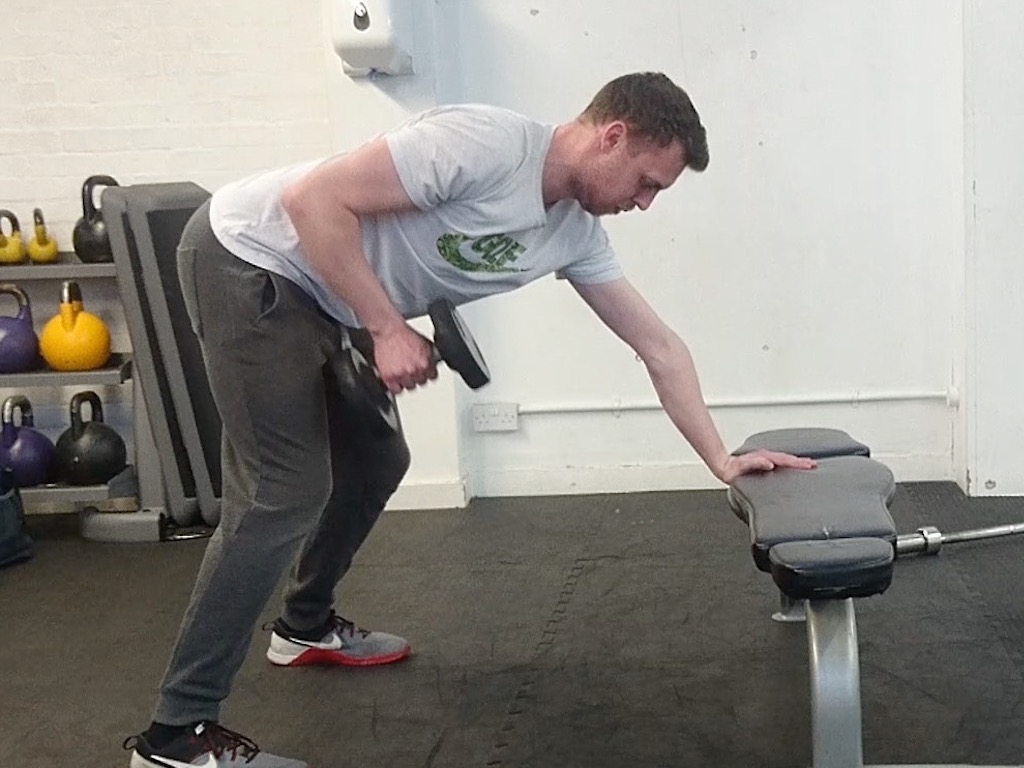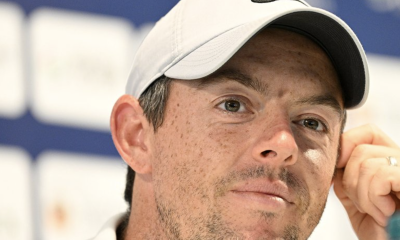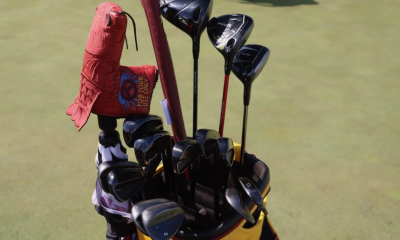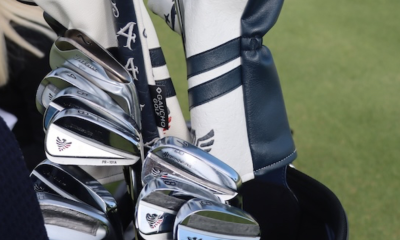Opinion & Analysis
6 must-have exercises in any golf fitness program

Golf is inherently an asymmetrical pattern. It also exposes the golfer to peak compressive forces of up to 8 times bodyweight through the lumbar spine. It’s no wonder then that the golf swing, when repeated over and over, can lead to the build up of physical asymmetries, overuse issues and injury.
Indeed, the literature relating to injuries in golf reports the most common injuries are due to overuse. Studies suggest time spent practicing and playing are significant factors that influence injury risk. Those who played at least four rounds per week or hit more than 200 balls per week were also shown to have significantly higher instances of injury. It has also been proposed in several studies that poor swing mechanics can accelerate this process. With this in mind, almost all keen golfers — not just the ones on tour — could benefit taking a proactive approach to managing their injury risk. It will likely prevent them from missing time on the course and keep them on the course for longer into old age.
It is fairly clear that managing the volume of golf swings and correcting faulty swing mechanics is likely a big part of the puzzle of preventing injury to golfers. There is also a large body of evidence to suggest appropriate strength training could also be used to reduce the injury risk to golfers. A huge, 2014 meta-study found that strength training reduced sports injuries by roughly 33 percent and overuse injuries by 50 percent. Interestingly, this study also found that stretching alone had no relationship to injury prevention.
“Implementing a training program that includes flexibility, strength and power training with correction of faulty swing mechanics will help the golfer reduce the likelihood of injury and improve overall performance,” another study concluded. The only problem is that golfers often make one of two mistakes in their training that prevent them from realizing these injury prevention benefits:
- They train with little regard to improved movement quality, jumping right to sexy-looking exercises without mastering the basic firsts. More on this later.
- They train too “sport-specific,” seeking to mimic the golf swing using bands and cables, for example. By training in a highly specific manner, they end up neglecting antagonist/ stabilizer muscles and reinforcing those asymmetries inherent in the golf swing.
As such, we do not want to spend a huge amount of gym time stressing the joints in the same specific way we do on the course already. MLB strength coach Eric Cressey probably said it best: “Specificity works great until you’re so specific that you wind up injured and have forgotten how to do everything else.”
Balanced strength development through foundational movement pattern training and compensation strength exercises should, instead, form the vast majority (at least 80 percent) of your training activities, both from a sports performance and injury prevention perspective. The foundational movement patterns in question are:
- Squat
- Hip Hinge
- Upper Body Push
- Upper Body Pull
- Single-Leg Work
- Core Intensive Work (such as dead-bugs, planks, pallof presses and weighted carries)
The real key to unlocking the benefits of the foundational movement patterns and long-term success in your training lies in emphasising movement quality and picking variations/ progressions of each movement to suit you, rather than sticking to dogmatically programmed exercises that may not fit your body, your current training experience or goals. In really broad terms, this probably equates to selecting the most difficult exercise progression you can do technically perfect for the desired number of reps.
With this in mind, the rest of this article will be focused on providing some specifics for the six foundational patterns. It will also outline a progression framework you can use to gauge the best variation for you currently and where you should aim to progress in the future. That said, I would be remiss not to mention that getting the exercise selection and progression right is where a good coach becomes really valuable. He or she is able to take a full injury history and complete various assessments of joint range of motion and dynamic mobility to make sure you’re starting in the right place and advancing at the proper pace.
Squat
The squat does a lot of great things. It teaches us to create and maintain appropriate position of the pelvis and core. It also helps us learn to create and absorb force while developing mobility in the hips, ankles and thoracic spine. I bet the image you have in your mind right now is that of a barbell back squat taken to the floor. That is one squat pattern variation, but it’s by no means the only way to squat. Everyone is different, therefore, everyone must squat differently and squat using the squat variation most appropriate for their current skill level and trainability.
The goblet squat is my favorite variation for most golfers, as the anterior loading helps to shift weight back while maintaining core/pelvic stability. It should also be noted that the barbell back squat might not be something the athlete ever uses, because their physical makeup might always be better suited to front-loaded squatting. That’s perfectly fine. Once again, the key is to find the “hardest” variation that you can do perfectly. From there, you’ll be able to train the squat pattern without internal restriction, get a great training effect and minimize joint stress. The goal is to move up the list over time and progress strategically.
Hip Hinge
The hinge is one of the most important patterns when it comes to protecting your lower back from injury, but many people have lost the ability do it. The hip hinge is often confused with the deadlift, which is a specific exercise that falls under the hip hinge umbrella (i.e. while not every hip hinge is a deadlift, every deadlift is a hip-hinge pattern).
Many people don’t deadlift because they think it’s too risky. And since the deadlift is the only hip hinge exercise they know, they skip training the entire movement pattern. This is a mistake. Master the hip hinge, and you’ll avoid chronic flare-ups, lower back tightness, and generalized “neural-lock” of your mobility and flexibility. The pattern should be slowly implemented at lower levels, however, which allows motor relearning to take place. Watch the video above to see the main progressions I use to reactivate the hip hinge from the ground up.
Not everyone will have the ability to pull a barbell off the floor with good neutral spine mechanics due to different body types. Again, totally fine. If that’s you, don’t feel the need to force it. Just stick with having the bar or kettlebell elevated off the floor as I have in the video. In fact, this is what I have the vast majority of my golfers do.
Single-Leg
Single-leg exercises unlock strength and movement quality potential. They tap into your “primitive patterning.” You learned to walk in a sequence. You rolled over, crawled, pulled yourself up and finally learned to stand and walk. Not all of that was unilateral, but the movement between the steps was. That primitive patterning is what single-leg movements are targeting for re-education.
There are few movements more powerful than single-leg variations for identifying weak links, sticking points and pain patterns. Again, we need to work from the ground up to build optimal patterns and movement efficiency to keep us strong and healthy.
The single-leg lunge pattern does include more dynamic lunges. Under its umbrella are single-leg squats involving standing only on one leg, lateral squat variations and hinge-based movements such as the single-leg RDL’s. For the sake of brevity I haven’t covered these, but this doesn’t devalue their importance in a good plan built around the non-negotiable foundational patterns. Be sure to include both the knee-dominant variations shown above, as well as the hip-dominant patterns such as single-leg RDLs to cover all your bases.
Upper Body Push
Movement patterns are classified as either open- or closed-chain depending on the contact points with the ground. If the hands and feet are in contact with a stable surface like the ground, the movement is a closed kinematic chain. If the hands or feet are freely moving through space, that’s an open kinematic chain.
With the push-up, the hands are anchored to the ground (or stable surface) that alter the way the spine, gleno-humeral joint, scapula and acute muscular stabilizers of the region move. In this closed chain, the shoulder blades are able to move freely against the thoracic cage placing more of a dynamic stability emphasis on the musculature controlling this position. This skill of creating stability and tension in the shoulders and upper back is something that must be mastered in order to translate into a more static, stability-based position such as the bench press.
Starting with the mastery of the plank and push-up allows the biggest bang for your buck in full-body motor learning through the push pattern. From integrated core and hip stability to upper back and shoulder tensional recruitment, the push-up is a key player in learning how to generate stability in order to display power and strength. Once this skill is honed in at the horizontal plane of motion, vertical pushing will be the next challenge.
Upper Body Pull
Strong and stable shoulders depend on pulling more than pushing. Our sitting- and bench press-dominated world (guys I’m looking at you) leads to tonic anterior shoulder and chest muscles, lengthened/weak posterior shoulder muscles and internally rotated shoulders. To combat this, I will often program pulling to pushing in a 2:1 or even 3:1 ratio. We must also bear in mind, however, that the vertical pull also places the shoulder into internal rotation during the movement pattern itself. This means we should bias the horizontal pull more than vertical pulling in our programming.
In order to create full-body stability at the shoulders through the pull, the horizontal pull must first be mastered before introducing the more complex vertical pull variations off the pull-up bar and beyond. Moreover, mastering the pull from a stable core and hips will help develop a strong posterior that can support athletic endeavors such as the golf swing. That’s exactly why this pattern must be a priority.
The pattern must first be introduced and perfected from a full-body, stability-based position. From this position, the pillar is challenged to generate tension and create stability through the legs, hips, pelvis and spine, while the upper body works to generate dynamic force.
Core Intensive Movements
The core muscles help safeguard the lumbar spine during sports, gym and everyday activities, and they are therefore crucial in preventing back pain. If the core is weak, then other muscles will have to compensate in order to stabilize the pelvis and spine, leading to faulty movement patterns, asymmetries and injury.
Golfers, for example, are more susceptible to lower back pain due to rotating at the lumbar spine. The rotation should occur through the pelvis and thoracic spine, with the lumbar spine remaining in a relatively fixed position. A strong core, in addition to the glutes and stretching out the anterior hip muscles, will help stabilize the pelvis back in more a neutral position. It helps prevent the lumbar spine from over extending and rotating into ranges of motion for which it is not designed.
Additionally, the core muscles link the upper and lower body. If a link in the body chain is broken, performance will suffer. Much of the power in the golf swing actually comes from the ground. In order to effectively transfer this ground reaction force through the body and to the club, the pelvis and spine need to be stable. This stability is achieved when the core muscles and glutes are strong and highly functioning.
Many train the core poorly, however. In short, you should train the function of the core — not it\s anatomy. This generally means training four patterns:
- Rotational Core Strength
- Anterior Core Strength
- Lateral Core Strength
- Hip Extension Strength/Bridging
For the sake of brevity, I offer an example of anterior or anti-extension core strength progressions in the video above.
Over To You
All you have to do now is give the variations a try. Pick the ones that work best for you. I suggest videoing yourself while doing them to ensure proper form.
Follow a sensible progression strategy, add in some mobility work for the weakness you’ll have identified by trying different variations and you have the nuts and bolts of a really useful injury prevention program. I willing to wager you’ll feel better and, as many of the physical qualities developed in these exercises are also needed in properly executing the golf swing, you’ll be playing better, too.
- LIKE174
- LEGIT18
- WOW6
- LOL4
- IDHT0
- FLOP1
- OB0
- SHANK12
19th Hole
Vincenzi’s 2024 PGA Championship betting preview: Rising star ready to join the immortals at Valhalla

The second major of the 2024 season is upon us as the world’s best players will tee it up this week at Valhalla Golf Club in Louisville, Kentucky to compete for the Wanamaker Trophy.
The last time we saw Valhalla host a major championship, Rory McIlroy fended off Phil Mickelson, Henrik Stenson, Rickie Fowler and the creeping darkness that was descending upon the golf course. The Northern Irishman had the golf world in the palm of his hand, joining only Tiger Woods and Jack Nicklaus as players who’d won four major championships by the time they were 25 years old.
Valhalla is named after the great hall described in Norse mythology where the souls of Vikings feasted and celebrated with the Gods. The course is a Jack Nicklaus-design that has ranked among Golf Digest’s “America’s 100 Greatest Courses” for three decades.
Valhalla Golf Club is a par-71 measuring 7,542 yards with Zoysia fairways and Bentgrass greens. The course has rolling hills and dangerous streams scattered throughout and the signature 13th hole is picturesque with limestone and unique bunkering protecting the green. The 2024 PGA Championship will mark the fourth time Valhalla has hosted the event.
The field this week will consist of 156 players, including 16 PGA Champions and 33 Major Champions.
Past Winners of the PGA Championship
- 2023: Brooks Koepka (-9) Oak Hill
- 2022: Justin Thomas (-5) Southern Hills
- 2021: Phil Mickelson (-6) Kiawah Island
- 2020: Collin Morikawa (-13) TPC Harding Park
- 2019: Brooks Koepka (-8) Bethpage Black
- 2018: Brooks Koepka (-16) Bellerive
- 2017: Justin Thomas (-8) Quail Hollow
- 2016: Jimmy Walker (-14) Baltusrol
- 2015: Jason Day (-20) Whistling Straits
- 2014: Rory McIlroy (-16) Valhalla
In this article and going forward, I’ll be using the Rabbit Hole by Betsperts Golf data engine to develop my custom model. If you want to build your own model or check out all of the detailed stats, you can sign up using promo code: MATTVIN for 25% off any subscription package (yearly is best value).
Key Stats For Valhalla
Let’s take a look at five key metrics for Oak Hill to determine which golfers boast top marks in each category over their past 24 rounds.
1. Strokes Gained: Approach
Valhalla will play as a true all-around test of golf for the world’s best. Of course, it will take strong approach play to win a major championship.
Strokes Gained: Approach Over Past 24 Rounds
- Shane Lowry (+1.25)
- Scottie Scheffler (+1.09)
- Jordan Smith (+1.05)
- Tom Hoge (+.96)
- Corey Conners (+.94)
2. Strokes Gained: Off the Tee
Valhalla will play long and the rough will be penal. Players who are incredibly short off the tee and/or have a hard time hitting fairways will be all but eliminated from contention this week at the PGA Championship.
Strokes Gained: Off the Tee Over Past 24 Rounds:
- Bryson DeChambeau (+1.47)
- Scottie Scheffler (+1.11)
- Keith Mitchell (+.90)
- Alejandro Tosti (+.89)
- Ludvig Aberg (+.82)
Strokes Gained: Total on Nickalus Designs
Valhalla is a classic Nicklaus Design. Players who play well at Nicklaus designs should have an advantage coming into this major championship.
Strokes Gained: Total on Nicklaus Designs over past 36 rounds:
- Jon Rahm (+2.56)
- Scottie Scheffler (+2.48)
- Patrick Cantlay (+2.35)
- Collin Morikawa (+1.79)
- Shane Lowry (+1.57)
Strokes Gained: Tee to Green on Very Long Courses
Valhalla is going to play extremely long this week. Players who have had success playing very long golf courses should be better equipped to handle the conditions of this major championship.
Strokes Gained: Total on Very Long Courses Over Past 24 Rounds:
- Scottie Scheffler (+2.44)
- Rory McIlroy (+2.24)
- Will Zalatoris (+1.78)
- Viktor Hovland (+1.69)
- Xander Schauffele (+1.60)
Strokes Gained: Total in Major Championships
One factor that tends to play a large role in deciding major championships is which players have played well in previous majors leading up to the event.
Strokes Gained: Total in Major Championships over past 20 rounds:
- Scottie Scheffler (+3.14)
- Will Zalatoris (+2.64)
- Rory McIlroy (+2.49)
- Xander Schauffele (+2.48)
- Tommy Fleetwood (2.09)
Strokes Gained: Putting on Bentgrass Greens
Valhalla features pure Bentgrass putting surfaces. Players who are comfortable putting on this surface will have an advantage on the greens.
Strokes Gained: Putting on Bentgrass Greens over Past 24 Rounds:
- Ludvig Aberg (+1.12)
- Denny McCarthy (+1.08)
- Matt Fitzpatrick (+0.99)
- Justin Rose (+0.93)
- J.T. Poston (0.87)
Strokes Gained: Total on Zoysia Fairways
Valhalla features Zoysia fairways. Players who are comfortable playing on this surface will have an advantage on the field.
Strokes Gained: Total on Zoysia Fairways over past 36 rounds:
- Justin Thomas (+1.53)
- Will Zalatoris (+1.47)
- Xander Schauffele (+1.40)
- Brooks Koepka (+1.35)
- Rory McIlroy (+1.23)
2024 PGA Championship Model Rankings
Below, I’ve compiled overall model rankings using a combination of the key statistical categories previously discussed — SG: Approach (25%), SG: Off the Tee (22%), SG: T2G on Very Long Courses (12%), SG: Putting on Bentgrass (+12%), SG: Total on Nicklaus Designs (12%). SG: Total on Zoysia Fairways (8%), and SG: Total in Major Championships (8%).
- Brooks Koepka
- Xander Schauffele
- Rory McIlroy
- Scottie Scheffler
- Bryson DeChambeau
- Shane Lowry
- Alex Noren
- Will Zalatoris
- Cameron Young
- Keith Mitchell
- Hideki Matsuyama
- Billy Horschel
- Patrick Cantlay
- Viktor Hovland
- Adam Schenk
- Chris Kirk
- Sahith Theegala
- Min Woo Lee
- Joaquin Niemann
- Justin Thomas
2024 PGA Championship Picks
Ludvig Aberg +1800 (BetMGM)
At The Masters, Ludvig Aberg announced to the golf world that he’s no longer an “up and coming” player. He’s one of the best players in the game of golf, regardless of experience.
Augusta National gave Aberg some necessary scar tissue and showed him what being in contention at a major championship felt like down the stretch. Unsurprisingly, he made a costly mistake, hitting it in the water left of the 11th hole, but showed his resilience by immediately bouncing back. He went on to birdie two of his next three holes and finished in solo second by three shots. With the type of demeanor that remains cool in pressure situations, I believe Ludvig has the right mental game to win a major at this point in his career.
Aberg has not finished outside of the top-25 in his past eight starts, which includes two runner-up finishes at both a “Signature Event” and a major championship. The 24-year-old is absolutely dominant with his driver, which will give him a major advantage this week. In the field he ranks, in Strokes Gained: Off the Tee, and has gained strokes in the category in each of his past ten starts. Aberg is already one of the best drivers of the golf ball on the planet.
In Norse mythology, Valhalla is the great hall where the souls of Vikings feasted and celebrated with the Gods. The Swedes, who are of Old Norse origin, were the last of the three Scandinavian Kingdoms to abandon the Old Norse Gods. A Swede played a major role in the 2014 PGA Championship at Valhalla, and I believe another, Ludvig Aberg, will be the one to conquer Valhalla in 2024.
Bryson DeChambeau +2800 (BetMGM)
Bryson DeChambeau is one of the few players in the world that I believe has the game to go blow-for-blow with Scottie Scheffler. Although he isn’t as consistent as Scheffler, when he’s at his best, Bryson has the talent to beat him.
At The Masters, DeChambeau put forth a valiant effort at a golf course that simply does not suit his game. Valhalla, on the other hand, is a course that should be perfect for the 30-year-old. His ability to overpower a golf course with his driver will be a serious weapon this week.
Bryson has had some success at Jack Nicklaus designs throughout his career as he won the Memorial at Muirfield Village back in 2018. He’s also had incredible results on Bentgrass greens for the entirety of his professional career. Of his 10 wins, nine of them have come on Bentgrass greens, with the only exception being the Arnold Palmer Invitational at Bay Hill. He also has second place finishes at Medinah and TPC Summerlin, which feature Bentgrass greens.
Love him or hate him, it’s impossible to argue that Bryson isn’t one of the most exciting and important players in the game of golf. He’s also one of the best players in the world. A second major is coming soon for DeChambeau, and I believe he should be amongst the favorites to hoist the Wanamaker Trophy this week.
Patrick Cantlay +4000 (FanDuel)
There’s no way of getting around it: Patrick Cantlay has been dissapointing in major championships throughout his professional career. He’s been one of the top players on Tour for a handful of years and has yet to truly contend at a major championship, with the arguable exception of the 2019 Masters.
Despite not winning majors, Cantlay has won some big events. The 32-year-old has won two BMW Championships, two Memorial Tournaments as well as a Tour Championship. His victories at Memorial indicate how much Cantlay loves Nicklaus designs, where he ranks 3rd in the field in Strokes Gained: Total over his past 36 rounds behind only Scottie Scheffler and Jon Rahm.
Cantlay also loves Bentgrass greens. Six of Cantlay’s seven individual wins on the PGA Tour have come on Bentgrass greens and he also was one of the best putters at the 2023 Ryder cup at Marco Simone (also Bentgrass). At Caves Valley (2021 BMW Championship), he gained over 12 strokes putting to outduel another Bentgrass specialist, Bryson DeChambeau.
Cantlay finished 22nd in The Masters, which was a solid result considering how many elite players struggled that week. He also has two top-ten finishes in his past five PGA Championships. He’s undeniably one of the best players in the field, therefore, it comes down to believing Cantlay has the mental fortitude to win a major, which I do.
Joaquin Niemann +4000 (BetMGM)
I believe Joaquin Niemann is one of the best players in the world. He has three worldwide wins since December and has continued to improve over the course of his impressive career thus far. Still only 25, the Chilean has all the tools to be a serious contender in major championships for years to come.
Niemann has been the best player on LIV this season. Plenty will argue with the format or source of the money on LIV, but no one can argue that beating players such as Jon Rahm, Bryson DeChambeau, Dustin Johnson, Brooks Koepka and Cameron Smith is an unremarkable achievement. Niemann is an elite driver of the golf ball who hits it farther than just about anyone in the field not named Bryson DeChambeau or (arguably) Rory McIlroy.
Niemann is another player who has been fantastic throughout his career on Bentgrass greens. Prior to leaving the PGA Tour, Bentgrass was the only green surface in which Joaco was a positive putter. It’s clearly a surface that he is very comfortable putting on and should fare around and on the greens this week.
Niemann is a perfect fit for Valhalla. His low and penetrating ball flight will get him plenty of runout this week on the fairways and he should have shorter shots into the green complexes than his competitors. To this point in his career, the former top ranked amateur in the world (2018) has been underwhelming in major championships, but I don’t believe that will last much longer. Joaquin Niemann is a major championship caliber player and has a real chance to contend this week at Valhalla.
- LIKE37
- LEGIT15
- WOW4
- LOL1
- IDHT1
- FLOP4
- OB3
- SHANK17
Opinion & Analysis
The Wedge Guy: What really makes a wedge work? Part 2

In my last post, I explained the basic performance dynamics of “smash factor” and “gear effect” as they apply to your wedges and your wedge play success. If you missed that post, you can read it here.
At the end of that post, I promised “part 2” of this discussion of what makes a wedge work the way it does. So, let’s dive into the other two components of any wedge – the shaft and the grip.
It’s long been said that the shaft is “the engine of the golf club.” The shaft (and grip) are your only connection to all the technologies that are packed into the head of any golf club, whether it be a driver, fairway, hybrid, iron, wedge or even putter.
And you cannot ignore those two components of your wedges if your goal is optimizing your performance.
I’ve long been an advocate of what I call a “seamless transition” from your irons into your wedges, so that the feel and performance do not disconnect when you choose a gap wedge, for example, instead of your iron-set-matching “P-club.” In today’s golf equipment marketplace, more and more golfers are making the investment of time and money to experience an iron fitting, going through trial and error and launch monitor measuring to get just the right shaft in their irons.
But then so many of those same golfers just go into a store and choose wedges off the retail display, with no similar science involved at all. And that’s why I see so many golfers with a huge disconnect between their custom-fitted irons, often with lighter and/or softer graphite or light steel shafts . . . and their off-the-rack wedges with the stock stiff steel ‘wedge flex’ shaft common to those stock offerings.
If your wedge shafts are significantly heavier and stiffer than the shafts in your irons, it is physically impossible for you to make the same swing. Period.
To quickly improve your wedge play, one of the first things you can do is have your wedges re-shafted with the same or similar shaft that is in your irons.
There’s another side of that shaft weight equation; if you don’t have the forearm and hand strength of a PGA Tour professional, you simply cannot “handle” the same weight shaft that those guys play to master the myriad of ‘touch shots’ around the greens.
Now, let’s move on to the third and other key component of your wedges – the grips. If those are not similar in shape and feel to the grips on your irons, you have another disconnect. Have your grips checked by a qualified golf club professionals to make sure you are in sync there.
The one caveat to that advice is that I am a proponent of a reduced taper in your wedge grips – putting two to four more layers of tape under the lower hand, or selecting one of the many reduced taper grips on the market. That accomplishes two goals for your scoring.
First, it helps reduce overactive hands in your full and near-full wedge swings. Quiet hands are key to good wedge shots.
And secondly, it provides a more consistent feel of the wedge in your hands as you grip down for those shorter and more delicate shots around the greens. And you should always grip down as you get into those touch shots. I call it “getting closer to your work.”
So, if you will spend as much time selecting the shafts and grips for your wedges as you do choosing the brand, model, and loft of them, your scoring range performance will get better.
More from the Wedge Guy
- The Wedge Guy: What really makes a wedge work? Part 1
- The Wedge Guy: The easiest-to-learn golf basic
- The Wedge Guy: Golf mastery begins with your wedge game
- LIKE6
- LEGIT3
- WOW0
- LOL1
- IDHT1
- FLOP0
- OB0
- SHANK5
19th Hole
Vincenzi’s 2024 Wells Fargo Championship betting preview: Tommy Fleetwood ready to finally land maiden PGA Tour title

The PGA Tour season ramps back up this week for another “signature event,” as golf fans look forward to the year’s second major championship next week.
After two weaker-field events in the Zurich Classic and the CJ Cup Byron Nelson, most of the best players in the world will head to historic Quail Hollow for one of the best non-major tournaments of the year.
Last season, Wyndham Clark won the event by four shots.
Quail Hollow is a par-71 measuring 7,521 yards that features Bermudagrass greens. The tree-lined, parkland style course can play quite difficult and features one of the most difficult three-hole stretches in golf known as “The Green Mile,” which makes up holes 16-18: two mammoth par 4s and a 221-yard par 3. All three holes have an average score over par, and water is in play in each of the last five holes on the course.
The field is excellent this week with 68 golfers teeing it up without a cut. All of the golfers who’ve qualified are set to tee it up, with the exception of Scottie Scheffler, who is expecting the birth of his first child.
Past Winners at Quail Hollow
- 2023: Wyndham Clark (-19)
- 2022: Max Homa (-8)
- 2021: Rory McIlroy (-10)
- 2019: Max Homa (-15)
- 2018: Jason Day (-12)
- 2017: Justin Thomas (-8) (PGA Championship)
- 2016: James Hahn (-9)
- 2015: Rory McIlroy (-21)
Key Stats For Quail Hollow
Strokes Gained: Approach
Strokes gained: Approach will be extremely important this week as second shots at Quail Hollow can be very difficult.
Total SG: Approach Over Past 24 Rounds
- Akshay Bhatia (+1.16)
- Tom Hoge (+1.12)
- Corey Conners (+1.01)
- Shane Lowry (+0.93)
- Austin Eckroat (+0.82)
Strokes Gained: Off the Tee
Quail Hollow is a long course on which it is important to play from the fairway. Both distance and accuracy are important, as shorter tee shots will result in approach shots from 200 or more yards. With most of the holes heavily tree lined, errant drives will create some real trouble for the players.
Strokes Gained: Off the Tee Past 24 Rounds:
- Ludvig Aberg (+0.73)
- Rory McIlroy (+0.69)
- Xander Schauffele (+0.62)
- Viktor Hovland (+0.58)
- Chris Kirk (+0.52)
Proximity: 175-200
The 175-200 range is key at Quail Hollow. Players who can hit their long irons well will rise to the top of the leaderboard.
Proximity: 175-200+ over past 24 rounds:
- Cameron Young (28’2″)
- Akshay Bhatia (29’6″)
- Ludvig Aberg (+30’6″)
- Sam Burns (+30’6″)
- Collin Morikawa (+30’9″)
SG: Total on Tom Fazio Designs
Players who thrive on Tom Fazio designs get a bump for me at Quail Hollow this week.
SG: Total on Tom Fazio Designs over past 36 rounds:
- Patrick Cantlay (+2.10)
- Rory McIlroy (+1.95)
- Tommy Fleetwood (+1.68)
- Austin Eckroat (+1.60)
- Will Zalatoris (+1.57)
Strokes Gained: Putting (Bermudagrass)
Strokes Gained: Putting has historically graded out as the most important statistic at Quail Hollow. While it isn’t always predictable, I do want to have it in the model to bump up golfers who prefer to putt on Bermudagrass.
Strokes Gained: Putting (Bermudagrass) Over Past 24 Rounds:
- Taylor Moore (+0.82)
- Nick Dunlap (+.76)
- Wyndham Clark (+.69)
- Emiliano Grillo (+.64)
- Cam Davis (+.61)
Course History
This stat will incorporate players that have played well in the past at Quail Hollow.
Course History over past 36 rounds (per round):
- Rory McIlroy (+2.50)
- Justin Thomas (+1.96)
- Jason Day (+1.92)
- Rickie Fowler (+1.83)
- Viktor Hovland (+1.78)
Wells Fargo Championship Model Rankings
Below, I’ve compiled overall model rankings using a combination of the five key statistical categories previously discussed — SG: Approach (27%), SG: Off the Tee (23%), SG: Total on Fazio designs (12%), Proximity: 175-200 (12%), SG: Putting Bermuda grass (12%), and Course History (14%).
- Wyndham Clark
- Rory McIlroy
- Xander Schauffele
- Shane Lowry
- Hideki Matsuyama
- Viktor Hovland
- Cameron Young
- Austin Eckroat
- Byeong Hun An
- Justin Thomas
2024 Wells Fargo Championship Picks
Tommy Fleetwood +2500 (DraftKings)
I know many out there have Tommy fatigue when it comes to betting, which is completely understandable given his lack of ability to win on the PGA Tour thus far in his career. However, history has shown us that players with Fleetwood’s talent eventually break though, and I believe for Tommy, it’s just a matter of time.
Fleetwood has been excellent on Tom Fazio designs. Over his past 36 rounds, he ranks 3rd in the field in Strokes Gained: Total on Fazio tracks. He’s also been incredibly reliable off the tee this season. He’s gained strokes in the category in eight of his past nine starts, including at The Masters, the PLAYERS and the three “signature events” of the season. Tommy is a golfer built for tougher courses and can grind it out in difficult conditions.
Last year, Fleetwood was the first-round leader at this event, firing a Thursday 65. He finished the event in a tie for 5th place.
For those worried about Fleetwood’s disappointing start his last time out at Harbour Town, he’s bounced back nicely after plenty of poor outings this season. His T7 at the Valero Texas Open was after a MC and T35 in his prior two starts and his win at the Dubai Invitational came after a T47 at the Sentry.
I expect Tommy to bounce back this week and contend at Quail Hollow.
Justin Thomas +3000 (DraftKings)
It’s been a rough couple of years for Justin Thomas, but I don’t believe things are quite as bad as they seem for JT. He got caught in the bad side of the draw at Augusta for last month’s Masters and has gained strokes on approach in seven of his nine starts in 2024.
Thomas may have found something in his most recent start at the RBC Heritage. He finished T5 at a course that he isn’t the best fit for on paper. He also finally got the putter working and ranked 15th in Strokes Gained: Putting for the week.
The two-time PGA champion captured the first of his two major championships at Quail Hollow back in 2017, and some good vibes from the course may be enough to get JT out of his slump.
Thomas hasn’t won an event in just about two years. However, I still believe that will change soon as he’s been one of the most prolific winners throughout his PGA Tour career. Since 2015, he has 15 PGA Tour wins.
Course history is pretty sticky at Quail Hollow, with players who like the course playing well there on a regular basis. In addition to JT’s PGA Championship win in 2017, he went 4-1 at the 2022 Presidents Cup and finished T14 at the event last year despite being in poor form. Thomas can return as one of the top players on the PGA Tour with a win at a “signature event” this week.
Cameron Young +3500 (DraftKings)
For many golf bettors, it’s been frustrating backing Cam Young this season. His talent is undeniable, and one of the best and most consistent performers on the PGA Tour. He just hasn’t broken through with a victory yet. Quail Hollow has been a great place for elite players to get their first victory. Rory McIlroy, Anthony Kim, Rickie Fowler and Wyndham Clark all notched their first PGA Tour win at Quail.
Throughout Cam Young’s career, he has thrived at tougher courses with strong fields. This season, he finished T16 at Riviera and T9 at Augusta National, demonstrating his preference of a tough test. His ability to hit the ball long and straight off the tee make him an ideal fit for Quail Hollow, despite playing pretty poorly his first time out in 2023 (T59). Young should be comfortable playing in the region as he played his college golf at Wake Forest, which is about an hour’s drive from Quail Hollow.
The 26-year-old has played well at Tom Fazio designs in the past and ranks 8th in the field in Strokes Gained: Total on those courses in his last 36 rounds. Perhaps most importantly, this season, Young is the best player on the PGA Tour in terms of proximity from 175-200 in the fairway, which is where a plurality and many crucial shots will come from this week.
Young is an elite talent and Quail Hollow has been kind to players of his ilk who’ve yet to win on Tour.
Byeong Hun An +5000 (FanDuel)
Byeong Hun An missed some opportunities last weekend at the CJ Cup Byron Nelson. He finished T4 and played some outstanding golf, but a couple of missed short putts prevented him from getting to the winning score of -23. Despite not getting the win, it’s hard to view An’s performance as anything other than an overwhelming success. It was An’s fourth top-ten finish of the season.
Last week, An gained 6.5 strokes ball striking, which was 7th in the field. He also ranked 12th for Strokes Gained: Approach and 13th for Strokes Gained: Off the Tee. The South Korean has been hitting the ball so well from tee to green all season long and he now heads to a golf course that should reward his precision.
An’s driver and long irons are absolute weapons. At Quail Hollow, players will see plenty of approach shots from the 175-200 range as well as some from 200+. In his past 24 rounds, Ben ranks 3rd in the field in proximity from 175-200 and 12th in proximity from 200+. Playing in an event that will not end up being a “birdie” fest should help An, who can separate from the field with his strong tee to green play. The putter may not always cooperate but getting to -15 is much easier than getting to -23 for elite ball strikers who tend to struggle on the greens.
Winning a “signature event” feels like a tall task for An this week with so many elite players in the field. However, he’s finished T16 at the Genesis Invitational, T16 at The Masters and T8 at the Arnold Palmer Invitational. The 32-year-old’s game has improved drastically this season and I believe he’s ready to get the biggest win of his career.
- LIKE9
- LEGIT4
- WOW1
- LOL1
- IDHT1
- FLOP1
- OB0
- SHANK1
-

 19th Hole3 days ago
19th Hole3 days agoBrandel Chamblee says this is the primary reason why Rory McIlroy hasn’t won a major in 10 years
-

 Whats in the Bag4 days ago
Whats in the Bag4 days agoTiger Woods WITB 2024 (May)
-

 19th Hole2 weeks ago
19th Hole2 weeks agoReport: LIV star turns down PGA Championship invite due to ‘personal commitments’
-

 19th Hole2 weeks ago
19th Hole2 weeks agoGary Player claims this is what ‘completely ruined’ Tiger Woods’ career
-

 Equipment1 week ago
Equipment1 week agoDetails on Justin Thomas’ driver switch at the Wells Fargo Championship
-

 Whats in the Bag3 weeks ago
Whats in the Bag3 weeks agoTeam McIlowry (Rory McIlroy, Shane Lowry) winning WITBs: 2024 Zurich Classic
-

 Whats in the Bag2 weeks ago
Whats in the Bag2 weeks agoKeegan Bradley WITB 2024 (May)
-

 News1 day ago
News1 day agoScottie Scheffler arrested, charged, and released after traffic incident at Valhalla





















bruce
Jun 7, 2018 at 3:43 pm
Most guys I see on the golf course can’t walk and invent a new golf swing every try. The sport of last resort.
Nick Buchan
Jun 8, 2018 at 8:51 am
There is some truth to that Bruce. Hence why I recommend most golfers start working on general patterns such as above to develop good movement, gait, etc before we start to add and supplement with some more golf specific stuff.
DB
Jun 5, 2018 at 8:58 am
Great article, and Imma let you finish, but… what is wrong with that guy’s arm?!?
Nick Buchan
Jun 8, 2018 at 8:50 am
I have a fair amount of laxity in my elbow joints – I can do some pretty freaky stuff with them and you should see my top of the backswing position. Something I probably should try to be aware of and correct more often as not the greatest stabilisation/ loading strategy but doesn’t seem to have any affect on me at all as yet to be honest.